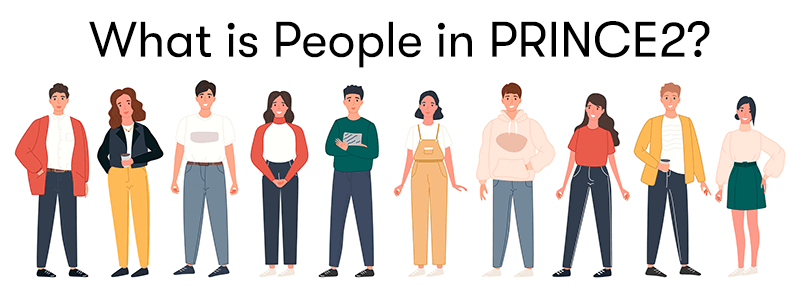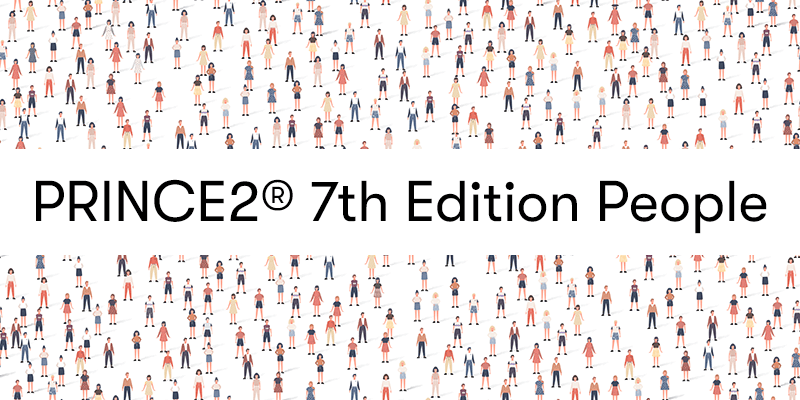PRINCE2 7th Edition People
Within the context of PRINCE2, the term ‘people’ encompasses both those actively engaged in a project and the interactions among them, in addition to those affected by the project. Organisations form intricate networks of ever-changing relationships. Irrespective of their primary intent, projects induce transformations within organisations. The triumph of a project hinges on its ability to forge robust affiliations with the supporting organisations facilitating its execution. Furthermore, its integration into the organisational framework to facilitate change delivery is pivotal.
Projects bring together a distinctive array of individuals from various spheres such as business, user, and supplier communities, all collaborating for a limited timeframe. To effectively accomplish project objectives, leadership across all tiers must foster a project-oriented culture that inspires individuals.
Decisions ought to be taken in proximity to where pertinent expertise resides. Escalation should occur only if there is a necessity to consider repercussions on other segments of the project environment, the larger organisational structure, or to manage broader political ramifications.
For more information on PRINCE2 people, please check out our PRINCE2 7 Foundation Course.
What is the Purpose of People?
The objective of a project is to bring about alterations that will influence individuals in their day-to-day business activities, established routines, and assigned duties. The effectiveness of the change execution, and consequently the project's success, relies on the competencies of the project team, the quality of the connections among team members, and the individuals who will be affected by the changes.
What is ‘People’ in PRINCE2?

People are the driving force for any project in PRINCE2, they manage, develop, implement and improve. But they are also accountable and responsible. PRINCE2 people also refers to stakeholders and people affected by the project. It is important to consider and evaluate every person a project touches throughout the project lifespan. People are also users of a project’s outcome or deliverable.
Leading Change
Every project leads to a transformation in the way individuals, institutions, and systems function, changing from the present condition to a future envisioned state that integrates the utilisation of project outputs. Competent leadership is imperative for achieving this transformation.
Change Management
Pinpointing the sectors within the organisation that will be affected during the project's shift from the existing status to the desired outcome characterises the change that the project will enact. PRINCE2 tackles change by formulating and upholding a change management strategy tailored to the project's needs.
It is also important to note that PRINCE2 can work alongside ITIL change management in this regard. Click here for more information on ITIL change management.
Stakeholders
Projects will have an influence on individuals throughout the entirety of the organisational framework. Consequently, a project must engage individuals with designated roles within the project team and essential individuals who are either affected by or indispensable for the project's triumph. These individuals constitute the stakeholders in the project, encompassing a comprehensive range of users, suppliers, and business representatives. These stakeholders might originate externally to both the project team and the business itself.
Stakeholders engaged at the project interface might shift over time as the project undergoes evolution and relationships mature.
The approach to initiating a project should facilitate the cultivation of relationships across interfaces. This can be achieved by organising routine gatherings and collaborative teams that foster a mutual comprehension of diverse viewpoints, project information, and the insights acknowledged by stakeholders.
Culture
Projects frequently amalgamate individuals from various segments of the organisational structure, each potentially operating within distinct work cultures. A project team might find it necessary to forge a project-oriented ethos that sets it apart from the overall business atmosphere, yet still maintains alignment with the broader organisational context.
A comprehensive grasp of the project, formulated in collaboration with influential figures, must be encapsulated within the project brief. This comprehensive comprehension, coupled with awareness of external legal and regulatory mandates, as well as pertinent business obligations, collectively furnishes a compass for multifaceted decision-making.
Drawing from the mutual understanding developed with key influencers, strategies can be devised to ensure that all affected aspects of the organisational structure remain appropriately engaged as the project unfolds. These approaches are encapsulated in the project's management methodologies. Establishing this shared understanding is also facilitated by the assignment of individuals to project roles, which includes decision-makers within the project board representing the interests of the business, users, and suppliers.
Leading Teams

Projects come to fruition through the efforts of individuals who form a transient team, frequently collaborating across the confines of organisational demarcations. Consequently, those designated to participate in projects frequently find themselves accountable to numerous chains of command. Such reporting links might originate from a section of the organisation that has temporarily allocated the individual to the project, or even from a supplier's establishment when external professionals contribute project expertise and proficiencies.
On occasion, individuals endowed with specialised skills and capacities are engaged across several projects or are attached to a project with part-time involvement. This intricacy generates connections to multiple overseers.
Apart from individuals formally designated to a project, there exist personnel within the business whose operations are impacted by the project, yet they do not constitute part of the officially defined project team. Their roles are often significant. They could also indirectly contribute by executing activities within their business domain to accommodate or extract advantages from the project.
When these activities fall beyond the boundaries of the predefined project scope, it becomes crucial to establish a clear comprehension of their dependencies, the designated individuals responsible for executing them, and the means by which they will be financed and supervised. If these tasks are not handled meticulously, projects can encounter delays or fail to realise their intended benefits.
Guiding individuals who exist beyond a project's immediate jurisdiction necessitates a degree of cultural wisdom. Cultural intelligence denotes the capability to effectively interact and collaborate within diverse cultural contexts present within the organisational structure.
Whether projects are conducted remotely, face-to-face, or by combining both methods, it's essential to meticulously contemplate the manner in which individuals collaborate. This consideration is crucial not only for maximising the efficient utilisation of people's time but also for fostering a sense of social unity.
Communication
Be it the project's primary goal or an accidental outcome, projects invariably instigate transformations within organisations. Consequently, projects frequently face heightened scrutiny and susceptibility to misunderstandings regarding their intent and consequences. In the absence of a transparent communication strategy, this can result in avoidable impediments when implementing alterations. Such barriers may arise as individuals strive to safeguard the status quo or mitigate the perceived adverse repercussions of the project.
A communication management strategy places equal emphasis on attentive listening and effective broadcasting. It aims to grasp the perceptions and apprehensions prevailing within the project environment, thus enabling their resolution prior to them evolving into more substantial risks. Simultaneously, this approach permits the tailoring of messages to align with the concerns and interests specific to diverse factions within both the project environment and the broader organisational context.
Employing generalised messages rarely yields desired outcomes, as individuals acquire information through an array of avenues. The identification and collaboration with pivotal influencers hailing from user, supplier, and business stakeholder sectors aid in accommodating various viewpoints. This practice guarantees robust feedback mechanisms and the capacity to fine-tune messaging for each of these distinct groups.
It is also important to note that how project teams communicate will also depend on whether they are co-located, remote, or hybrid working.
How are People Important to Project Management?

Quite simply put, without people there would be no project. Projects are built and managed by people. By considering people while managing or planning a project, you can increase likelihood the desired outcome of the project is delivered. Many projects desired outcome also affect many people or are designed for users to interact with. The significance of people in PRINCE2 is vast and it is imperative to consider all people when managing a project.
People and Principles

At the core of PRINCE2 is the 7 principles. Here are how people interlink with each of the 7 principles:
Ensure Continued Business Justification
Organisations essentially consist of individuals engaged in mutual interactions centred around the fundamental objectives of said organisation. The rationale supporting a project must effectively cater to the interests of all three project stakeholders: users, the business itself, and suppliers. Crafting a project that harmonises these diverse interests requires considerable time and effort. Hence, it is pivotal to account for the intricate dynamics of the pivotal relationships connected to these interests. These dynamics influence how consensus is achieved and determine the project's ongoing validity. Furthermore, it's essential to acknowledge that what might be deemed justifiable can shift with changing roles.
The justification from a business perspective can be influenced by perceptions. Therefore, an effective communication management approach stands as a pivotal facilitator, ensuring an enduring sense of business justification through the adept management of crucial relationships and the demonstration of progress to underscore value.
Learn from experience
Extracting considerable insights from explicit knowledge sources, like business literature and recorded learnings, is undeniable; however, there exists a trove of invaluable knowledge concealed within a project's intricate ecosystem. Realising this potential demands a cooperative setting that fosters the continual exchange of knowledge throughout a project's duration. This practice of knowledge sharing empowers individuals to reap the benefits of each other's experiential wisdom.
Notably, factors anchored in human interactions such as behaviours, cultural dynamics, and relationships are arduous to codify and are most effectively absorbed through social learning. An exemplar is team members connecting and gleaning insights from those who have participated in earlier phases or similar projects marked by analogous characteristics.
Define roles, responsibilities, and relationships
This principle is entirely intertwined with people, this guarantees that human aspects are consistently attended to throughout the project's entire duration.
Manage by stages
The project's phases frequently signify shifts in the individuals exerting influence and any critical alliances. These junctures serve as opportune moments to assess the project's delivery strategy, ensuring its continued synchronisation with the prevailing dynamics of interpersonal interactions and the broader organisational context. Notably, these stage demarcations often correspond with shifts in the organisational structure.
Stage transitions provide a more structured avenue for evaluating the requisite skills essential for forthcoming delivery phases and effecting modifications, even within the Project Board if necessary. It is more prudent to have capable individuals overseeing the project rather than individuals who are unable to make meaningful contributions.
Manage by exception
Decisions ought to be formulated at the most localised level where the necessary expertise to craft and take responsibility for these decisions is situated. However, when a decision carries the potential to reverberate across various facets of the project, it should progress through hierarchical levels. This is particularly crucial when multiple viewpoints need consideration, or when the decision's impact extends beyond the project's confines.
The extent of delegation is often contingent upon the level of assurance and reliance established within pivotal relationships, and this degree of delegation will evolve over the project's duration in response to the evolving proficiencies of individuals. Enhancing confidence and trust bolsters the capacity to manage through exceptional circumstances.
Focus on products
Collaboratively crafting products, supported by mutually accepted product descriptions from the business, user, and supplier segments, brings together their diverse viewpoints. This collaborative approach enhances the creation and acceptance of these products within the business context, diminishing the risks associated with handovers and guaranteeing comprehensive contemplation of operational and maintenance concerns.
Tailor to suit the project
Tailoring empowers the customisation of the PRINCE2 method to suit the individuals and organisations engaged, rather than striving to conform them to the method itself. Tailoring is contingent upon the degree of proficiency or project management expertise, which will naturally progress as individuals attain a more profound comprehension of PRINCE2 principles, practices, and procedures over time.
Click here for more information on PRINCE2 7th Edition Principles.
People and Practices

PRINCE2 outlines seven practices that constitute integral elements of project management and must be consistently and concurrently applied throughout the project's lifespan. The organising practice delineates how individuals assemble within a transitory project management team. This approach guarantees the incorporation of user, supplier, and business interests in the project, thus shaping the blueprint and establishment of the project's structure.
Human considerations are embedded in all these practices. For instance, crafting the business case necessitates a multi-faceted outlook sourced from various echelons of the organisational ecosystem. This comprehensive approach ensures lucidity regarding the project's objectives and fosters a shared comprehension to evolve across the project team.
Click here for more information on PRINCE2 7th Edition Practices.
People and Processes
The PRINCE2 procedures are structured across four tiers: business, direction, management, and execution. Processes within these tiers encompass considerations related to human dynamics, such as behaviours, culture, and relationships. They elucidate how individuals interact at the intersections between these layers.
Click here for more information on PRINCE2 7th Edition Processes.
Final Notes of PRINCE2 7th Edition People
The five cohesive components of the PRINCE2 approach are intricately orchestrated to operate in harmony. The methodology practices guarantee the consistent application of the guiding principles throughout the project processes, tailored to the project's unique circumstances (Project Context). They take into account the connections and needs of both the individuals within the project team and those external to it (People).


